News: NSW Fair Trading has released the Tow truck operator self-audit checklist, use the checklist to check your tow truck business meets its obligations under the law.
This information has been developed to assist tow truck drivers to understand their requirements. It is not a legal document and in no way alters or affects the operation of the Tow Truck Industry Act 1998 (the Act) or the Tow Truck Industry Regulation 2020 (the Regulation).
The Act requires that the driver of a tow truck must hold a driver certificate issued by NSW Fair Trading. Serious penalties may be imposed for driving and operating a tow truck without an appropriate certificate.
Why do I need a tow truck driver certificate?
Certification is the system used by NSW Fair Trading to assess whether a person is of suitable character and fitness, aware of their responsibilities, and able to conduct themselves appropriately when driving and operating a tow truck. In this way, it can be seen as a type of quality assurance system for tow truck operations.
The certificate also allows members of the community to easily identify that a tow truck driver is authorised to tow their vehicle.
As a tow truck driver, you have certain responsibilities under the Act and the Regulation. The information provided below is intended as a guide to those responsibilities.
For more detailed information on specific subjects please refer to the Act or the Regulation.
If you have any questions or you would like clarification of any of the responsibilities listed below, please contact the NSW Fair Trading Tow Truck Investigation Unit or phone 133 220.
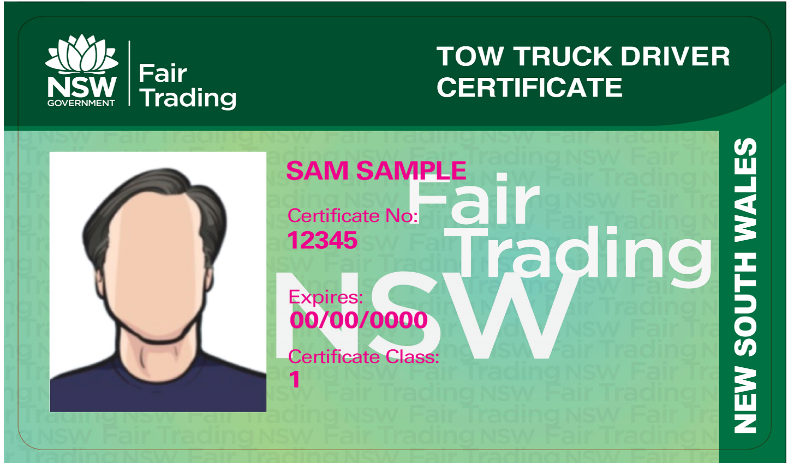
Your responsibilities
You must hold a current tow truck driver certificate at all times.
If at any time your motor vehicle driver’s licence is revoked, cancelled or suspended, your tow truck driver certificate is also cancelled and you must inform NSW Fair Trading. You must then notify NSW Fair Trading when your licence is reinstated.
If you are convicted of a criminal offence, your driver certificate may be affected. You must notify NSW Fair Trading in writing, not more than 14 days after a conviction or finding of guilt. For more information please contact us.
You must wear your driver certificate so that it is clearly visible while you are:
- at, or in the vicinity of a motor vehicle accident, or
- driving or standing a tow truck on a road or road-related area, or
- carrying out, or attempting to obtain, any towing work, or
- travelling in a tow truck as a passenger, or
- otherwise using or operating a tow truck.
You must produce your driver certificate on demand to an authorised officer or police officer.
You must notify NSW Fair Trading in writing of any proposed change in the particulars specified in your driver certificate. This notification must be given as soon as practicable after the proposed change occurs.
Your behaviour
You must behave in a respectful and orderly manner at all times while:
- operating the tow vehicle, or
- attending the scene of a motor vehicle accident, or
- complying with the requirement of an authorised officer
- comply with any reasonable requirements made of you by an authorised officer or police officer
- comply with any reasonable requirement made of you by an emergency services officer who is attending the scene of a motor vehicle accident
- at any other time in the conduct of towing work or towing operations.
Touting and soliciting for work
You must not, for the purpose of obtaining towing or repair work, or for the purpose of enabling any other person to obtain towing or repair work, give or receive, or offer to give or receive, any inducement or valuable thing (including money).
You must not obtain or attempt to obtain from any person, the other person's authority for the repair of a motor vehicle that has been involved in an accident before it is delivered to the place specified in the towing authorisation.
You must not, by threats, intimidation or coercion, do anything to any person for the purpose of any of the following:
- obtaining towing work
- enabling another person to obtain towing work
- preventing any other person from obtaining towing work
- obtaining the work of repairing a motor vehicle that has been involved in an accident or that otherwise requires towing
- enabling any other person to obtain the work of repairing a motor vehicle that has been involved in an accident or that otherwise requires towing
- preventing any other person from obtaining the work of repairing a motor vehicle that has been involved in an accident or that otherwise requires towing.
Protective clothing
It is a condition of your certificate that you comply with the protective clothing policy and wear the following whenever driving or operating a tow truck:
- Fluorescent shirt/vest – Must be clearly visible at all times. At times when non-reflective jackets or wet weather clothing is worn, a reflective vest/shirt must be worn over the top of the item.
- Protective footwear – must be fully enclosed steel cap type boots or shoes. Thongs, sandals, runners or similar types of footwear do not comply.
- Approved clothing – must be industrial clothing made from a material that complies with the Australian Standards. Football shorts, tracksuit pants, dress trousers or similar types of clothing do not comply.
- 'Towing' on shirt/vest – must have ‘TOWING’ in block letters at least 7 cm across the back of the shirt/vest. (4 digits trucks only)
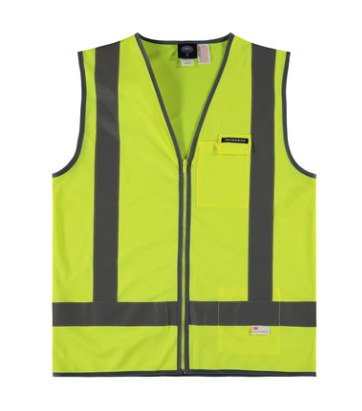 |  | 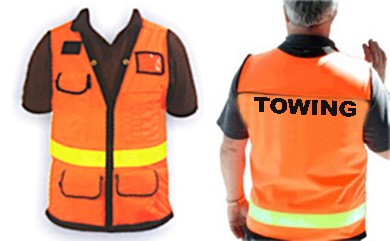 |
| Fluorescent vest | Protective footwear | 'Towing' printed on back of vest |
Tow truck equipment
You must ensure the following equipment is kept and maintained in each tow truck that you drive:
- a flashing or rotating warning light that is maintained in good working order, and
- fully adjustable mounted lights (in good working order) for loading and unloading of motor vehicles during hours of darkness.
Note: It is a requirement to have this equipment fitted and operational to reduce the risk of potentially hazardous incidents for you and others while the tow truck is in the process of loading or unloading motor vehicles.
In addition, if you operate a Category ‘A’ or a tow truck that is permitted to attend accidents, the truck must contain the following equipment at all times:
- broom – handle must be at least 1 metre long
- shovel – handle must be at least 1 metre long
- durable container for the storage of any accident debris, ie bucket or similar container. Plastic garbage bags or hessian sacks are not suitable for this use
- foam or dry chemical powder fire extinguisher (4.5 kg capacity).
Vehicle number plates
You must ensure that the tow vehicle number plates are visible while towing. If the number plate is likely to be obscured by a motor vehicle that is being towed, you must ensure that the number plate is displayed:
- at the rear of the towed vehicle, or
- in such other manner so that it remains clearly visible.
Note: The operator's name and licence number must be clearly displayed on the driver's side of the vehicle, and there must be a copy of the operator's schedule in the vehicle.
Information for drivers of Category ‘A’ accident tow trucks
Towing authorisations
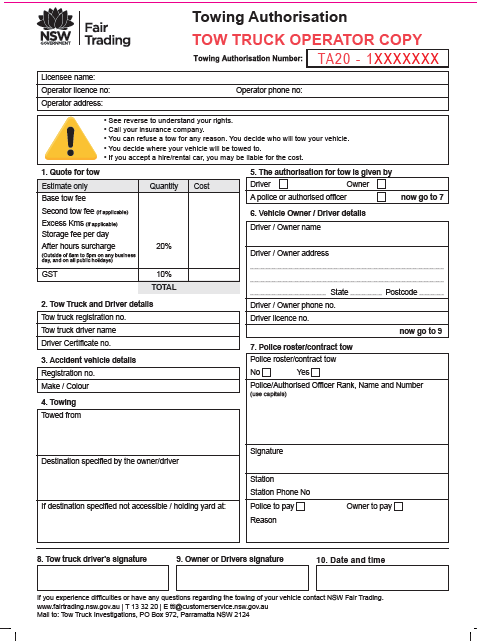
A towing authorisation must:
- be in writing in the towing authorisation book supplied to you
- be signed by you and the person who has given the authorisation
- specify the address where the motor vehicle is to be towed
- specify an alternate address being the licensee’s holding yard
- be filled out in full.
The person signing the authorisation must read and understand the declaration before signing it.
When you obtain a towing authorisation, you must:
- immediately give a copy of the towing authorisation to the person who gave you the authorisation (blue copy)
- within 72 hours of completing the towing work, deliver the original towing authorisation to the operator (white copy)
- retain a copy of the towing authority in the towing authorisation book (pink copy).
A towing authorisation may only be given by the owner/driver of the vehicle, a police officer or an authorised officer who are at the scene of the motor vehicle accident.
You must not tow a vehicle that has been involved in an accident unless you first obtain a towing authorisation or are acting under the direction of a police officer or authorised officer.
You must not obtain, or attempt to obtain, a towing authorisation unless the tow truck that will perform the tow is standing at or in the vicinity of the scene of the accident.
The towing authorisation only authorises the towing of the motor vehicle that is specified in the authority. It does not authorise you to tow another vehicle or organise the towing of another vehicle by another tow truck driver.
If you obtain the authorisation to tow a motor vehicle, you must tow the vehicle to the destination specified on the authorisation.
You must not, without reasonable excuse, alter a towing authorisation after it has been signed.
Towing notices
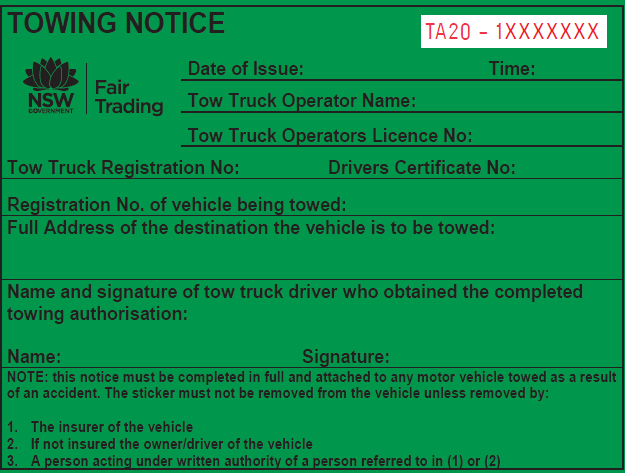
Before you tow the vehicle, you must complete and attach a towing notice (green sticker) that contains the following information:
- the serial number of the towing authorisation
- the operator’s name and licence number
- your name and your certificate number
- the registration number of the motor vehicle
- the place where the motor vehicle is to be towed.
You must not remove a towing notice unless instructed by the insurer, or the owner or driver of the vehicle.
If you are directed by a police officer or an authorised officer to tow a motor vehicle without having to obtain a towing authorisation, you must tow the vehicle to:
- the place specified by the police officer or the authorised officer, or
- the nearest place where the motor vehicle will not be an unreasonable obstruction to traffic.
Towing fees
You cannot charge more than the maximum fee determined by NSW Fair Trading for an accident tow or salvage tow.
Current towing fees are available on the NSW Fair Trading website.
Cleaning up after an accident
Before leaving the scene of a motor vehicle accident, you must remove any debris caused by, or relating to, the motor vehicle you are towing unless otherwise directed by a police officer.
Comply with the direction of authorised officers
When attending the scene of a motor vehicle accident, you must comply with any reasonable direction given to you by an authorised officer, police officer or emergency services officer who is present at the scene and is exercising his or her official duties.
Persons not permitted to travel as passengers in a tow truck
No one can travel as a passenger in a tow truck that is proceeding to or from the scene of a motor vehicle accident unless that person:
- was the driver of, or was a passenger in a motor vehicle involved in the accident, or
- is a certified driver who is travelling for the purpose of assisting you in carrying out towing work.
Tow truck to remain at the accident site for minimal period
You must not stand the tow truck at or within 500 metres of the scene of a motor vehicle accident:
- for a period longer than is reasonably necessary
- to obtain a towing authorisation, and
- to secure the motor vehicle to or onto the tow truck, or
- to clean up the debris after the accident, or
- without a reasonable excuse.